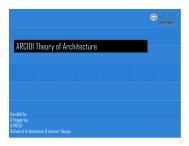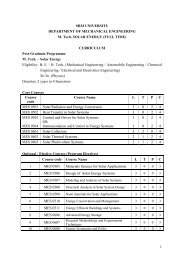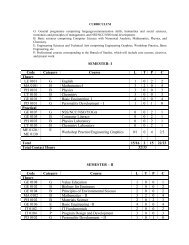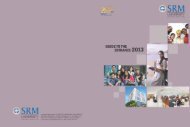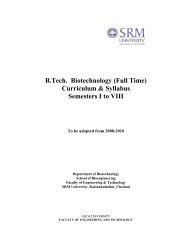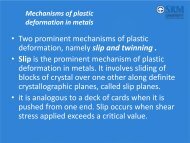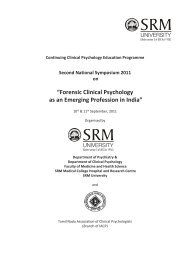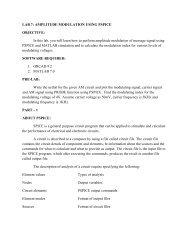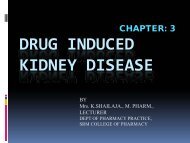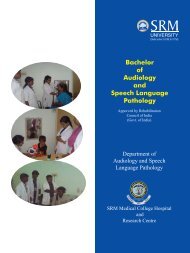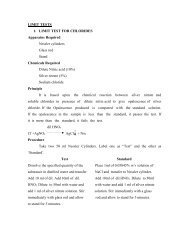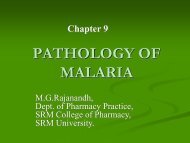EI0312 VLSI - SRM University
EI0312 VLSI - SRM University
EI0312 VLSI - SRM University
Create successful ePaper yourself
Turn your PDF publications into a flip-book with our unique Google optimized e-Paper software.
Course Code : EI0310<br />
Course Title : <strong>VLSI</strong> and Embedded Systems<br />
Year& Semester : 06<br />
Course duration : Jan-May 2012 (Even semester)<br />
Location : Tech park<br />
Faculty Details:<br />
<strong>SRM</strong> UNIVERSITY<br />
Faculty of Engineering and Technology<br />
DEPARTMENT OF EIE<br />
Name of the staff Section Office Office Mail ID<br />
Hours<br />
Mrs. G.Deiva Durga<br />
EIE-A<br />
EIE -B<br />
Tech Park 8.30-4 pm deivadurga.g@ktr.srmuniv.ac.in<br />
Required Text Books:<br />
• Wayne Wolf, Modern <strong>VLSI</strong> Design (System on Silicon), Prentice Hall PTR 2000<br />
• Michael John Sabestian Smith, Application Specific Integrated circuits, 2002<br />
• Douglas Pucknell, Basic <strong>VLSI</strong> Design Systems and Circuits, Prentice Hall PTR 2000<br />
• Neil Weste & Kamran Eshrangian, Principles of CMOS <strong>VLSI</strong> Design, Addison Wesley, 2nd edition 1998<br />
• Jacob Baker, Harry, David E.Boyce, CMOS Circuit Design, Layout and Simulation, Prentice Hall India 1998<br />
Web Resource:<br />
Objective:<br />
www.en.wikipedia.org/wiki/<strong>VLSI</strong>_engineering<br />
The students will be able to understand the techniques<br />
• MOS device operation, fabrication and designing gates<br />
• Circuits using MOS transistors<br />
• Basics of Sequential system design<br />
• Introduction to ASIC<br />
• Introduction to fault models and testing<br />
Tentative test details and portions:<br />
Cycle Test – I : UNIT-I & II (4.02.2013)<br />
Cycle Test –II : UNIT-III & IV (4.03.2013)<br />
Model Exam : ALL 5 UNITS (15.04.2013)
Assessment details:<br />
Cycle test-I<br />
10 points<br />
Cycle test-II<br />
10 points<br />
Model exam<br />
10 points<br />
Surprise test<br />
5 points<br />
Attendance<br />
5 points<br />
Total 50<br />
Outcomes:<br />
Students who have successfully completed this course<br />
Study of MOS technology and circuits.<br />
Gain knowledge of Layout and digital Circuits.<br />
Understanding of ASIC<br />
Purpose FPGA<br />
Knowledge of Faults<br />
The students will be able to understand the types<br />
of MOS, their properties and their design with<br />
stick diagrams<br />
The Students will be able to analyze scaling in<br />
MOS, pass transistor, Supper Buffer, Clocking<br />
Strategies, PLA and PAL design.<br />
The students will have a broad knowledge in<br />
Floor planning, Placement and routing.<br />
The Students will be able to acquire knowledge<br />
about FPGA<br />
The students can acquire a clear knowledge of<br />
testability, controllability and observability of the<br />
model,<br />
Detailed Session Plan:<br />
DAY NAME OF THE TOPICS REFERENCE<br />
UNIT-I<br />
1 Digital systems and <strong>VLSI</strong><br />
2 CMOS Technology<br />
3 Bipolar technologies<br />
MOS circuits electrical properties<br />
4 Integrated Circuit Design Techniques<br />
5 Transistors and Layout<br />
6 Fabrication Process of nMOS<br />
7 Fabrication process of CMOS<br />
8 Stick diagram and Layout<br />
9 Design Rules<br />
UNIT-II<br />
10 Introduction to Logic Gates<br />
11 Combinational Logic Functions and Static<br />
Complementary Gates<br />
12 Wires and Delays, Switch Logic<br />
1. Douglas A. Pucknell,<br />
Basic <strong>VLSI</strong> Design<br />
Systems and Circuits,<br />
Prentice Hall of India,<br />
1993<br />
2. Wayne Wolf, Modern<br />
<strong>VLSI</strong> Design (System on Silicon),<br />
Prentice Hall PTR 2000<br />
1. Douglas A. Pucknell,<br />
Basic <strong>VLSI</strong> Design<br />
Systems and Circuits,<br />
Prentice Hall of India,<br />
1993
13 Alternative Gate Circuits 2. Wayne Wolf, Modern<br />
14 Combinational Logic Networks<br />
<strong>VLSI</strong> Design (System on Silicon),<br />
Prentice Hall PTR 2000<br />
15 Layout Design Methods<br />
16 Combinational Network Delay<br />
17 Cross Talk - Power Optimization<br />
18 Switch Logic Networks - Combinational Logic<br />
Testing.<br />
UNIT-III<br />
19 Sequential Machines<br />
20 Latches and Flipflops<br />
21 Sequential system and Clocking discipline<br />
22 Sequential System Design - Power Optimization<br />
23 Design Validation - Sequential Testing<br />
24 Subsystem design - Combinational Shifters<br />
25 Adders- ALU - Multipliers<br />
26 High Density Memory<br />
UNIT-IV<br />
27 Application Specific Integrated Circuits<br />
28 Types of ASIC<br />
29 Design Flow of <strong>VLSI</strong><br />
30 Types of Simulation<br />
31 Programmable ASIC<br />
32 Floor planning - Placement<br />
33 Partitioning - Routing<br />
UNIT-V<br />
34 Types of PLD, FPLA<br />
35 FPGA Architecture<br />
36 Fault Models - Stuck-at-Faults<br />
37 Design for testability<br />
38 Design for controllability<br />
39 Design for absorvability<br />
40 LFSR - Boundary Scan Techniques.<br />
1. Douglas A. Pucknell,<br />
Basic <strong>VLSI</strong> Design<br />
Systems and Circuits,<br />
Prentice Hall of India,<br />
1993<br />
2. Wayne Wolf, Modern<br />
<strong>VLSI</strong> Design (System on Silicon),<br />
Prentice Hall PTR 2000<br />
1. Wayne Wolf, Modern <strong>VLSI</strong><br />
Design (System on Silicon),<br />
Prentice Hall PTR 2000<br />
2. Michael John Sabestian Smith,<br />
Application Specific Integrated<br />
circuits, 2002<br />
1. Michael John Sabestian Smith,<br />
Application Specific Integrated<br />
circuits, 2002



